|

|
|
| |
|
China Oil Painting Direct
|
|
100% hand painted, 100%
cotton canvas,
100% money back if not satisfaction.
|
|
|
|
ART WORKS
INDEX
A B C D E F G H I J K L M N O P Q R S T U V W X Y Z
|
|
ARTISTS
INDEX
A B C D E F G H I J K L M N O P Q R S T U V W X Y Z
|
|
|
|
 |
August Strindberg 
|
|
1849-1912
Swedish painter, sculptor and playwright. He had no art training, but learnt from artist friends after abandoning his studies at the University of Uppsala in 1872. The chief influence on him was Per Ekström, whose broken colour-spot technique he attempted to copy during his initial painting period in 1872-4 in Stockholm and on the skerry-islands Kymmendö and Sandhamn. Very little of Strindberg's early painting survives, but he had already found his special motifs: the sea, usually with turbulent waves; solitary trees or flowers on bare cliffs or sandy beaches in the outermost fringe of the skerries. After he stopped painting in 1874 he became Sweden's leading art critic, as well as the ideological leader of the radical Swedish artists' movement, which in 1884 formed the Konstnärsförbund (the Artists' Association) in protest against the Academy of Art. Prominent among the members were the painters Carl Olof Larsson, Karl Nordström and Richard Bergh. During this period, however, he produced sketches in words and pictures as illustrations to his own writings, which Carl Larsson was commissioned to do thereafter. From 1883 he stayed abroad, primarily in France and Switzerland, and belonged during a couple of long periods to the Scandinavian artists' colony in Grez-sur-Loing, near Fontainebleau in France. In 1886 in Switzerland he started photography and took a series of self-portraits that were intended for publication
|
|
 |
August Xaver Karl von Pettenkofen 
|
|
painted Zigeunerkinder in 1855
|
|
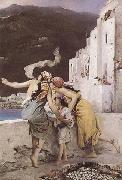 |
Auguste Alexandre Hirsch 
|
|
1833-1912
|
|
 |
Auguste Bigand 
|
|
France (1803 - ) - Drawer
|
|
 |
Auguste Borget 
|
|
Auguste Borget (1808-1877) was a French artist who is best known for his drawings and prints of exotic places, in particular China. He was born in 1808 in Issoudun, Indre. At age 21, he went to Paris where he became a close friend of Honore de Balzac. Borget periodically exhibited at the Paris Salon from 1836 to 1859. Beginning in 1836, he traveled through North and South America before stopping briefly in Honolulu in May, 1838, on board the ship "Psyche", on a world tour. He went to Canton in September 1838 and stayed in the region for 10 months. While in Canton, he met the English artist George Chinnery, and they went on sketching trips together.
In July 1839 he visited Manila, Singapore and Calcutta. In 1840 he traveled widely in India, returning to Paris in the summer of that year. Borgetes sketches and watercolors from China were the basis for his most famous publication "Sketches of China and the Chinese", published in 1842. His book "La Chine ouverte" was illustrated with fine woodcut engravings. A major Salon of his original works, including watercolors and boldly executed oil paintings was held in Paris in 1843. Borget died in 1877.
|
|
 |
Auguste Bouvier 
|
|
1825-1881
|
|
 |
Auguste Chabaud 
|
|
1882-1955,French painter, sculptor and writer. He trained at the Ecole des Beaux-Arts in Avignon with Pierre Grivolas (1824-1905). After moving to Paris in 1899 he attended Fernand Cormon's atelier in the Ecole des Beaux-Arts and William-Adolphe Bouguereau's studio in the Acad?mie Julian. He also studied at the Acad?mie Carriere, where he met Matisse, Jean Puy, Andre Derain and Pierre Laprade. While family responsibilities from 1901 and military service in World War I sharply curtailed much of his early output, he nonetheless produced noteworthy paintings and sculptures from 1907, the first year he exhibited at the Paris Salon, to 1913, when he exhibited at the Armory Show in New York.
|
|
 |
Auguste Couder 
|
|
(1 April 1790 in Paris - 21 July 1873 in Paris) was a French painter and student of Jean-Baptiste Regnault and Jacques Louis David. He joined the Academie des beaux-arts in 1839 and was an officer of the Legion d'honneur. He married Cornelie Stouf, daughter of the sculptor Jean-Baptiste Stouf.
Couder was buried in the cemetery of Pere-Lachaise.
|
|
 |
Auguste de Chatillon 
|
|
(1808 - 1881)
|
|
 |
Auguste Frederic Dufaux 
|
|
French impression artist
1852-1943
|
|
 |
Auguste Leveque 
|
|
(b. Nivelles, Walloon Brabant 1866 - d. Saint-Josse-ten-Noode, 1921) is a Belgian painter influenced both by realism and symbolism. Leveque was also a sculptor, poet and art theoretician.
He studied under Jean-François Portaels at the Academie Royale des Beaux-Arts in Brussels, and received the Prix Godecharle for his painting Job in 1890.
Leveque was a member of the "Salon d'Art Idealiste", formed by Jean Delville in Brussels in 1896, which is considered the Belgian equivalent to the Parisian Rose & Cross Salon. Other members of the group were Leon Frederic, Albert Ciamberlani, Constant Montald, Emile Motte, Victor Rousseau, Armand Point and Alexandre Seon. The Salon was abandoned in 1898.
|
|
 |
auguste macke 
|
|
August Macke (1887-1914) was a German painter whose harmonious and simple scenes of everyday life made a unique contribution to Expressionism.
|
|
 |
Auguste Rodin 
|
|
French Sculptor, 1840-1917
.French sculptor. Insolvent and repeatedly rejected by the École des Beaux-Arts, he earned his living by doing decorative stonework. Not until his late 30s, after a trip to Italy, did he develop a personal style free of academic restraints and establish his reputation as a sculptor with The Age of Bronze (exhibited 1878), whose realism was so great that he was accused of forming its mold on a living person. His Gates of Hell, a bronze door commissioned in 1880 for a proposed Musee des Arts Decoratifs, remained unfinished at his death, but two of its many figures were the bases of his most famous images, The Thinker (1880) and The Kiss (1886). His portraits include monumental figures of Victor Hugo and Honore de Balzac. Though these and many other works caused controversy for their unconventionality, he was successful enough that he could establish a workshop where he executed only molds, leaving the casting of bronze and the carving of marble to assistants. To his sculpture he added book illustrations, etchings, and numerous drawings, mostly of female nudes.
|
|
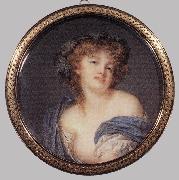 |
AUGUSTIN, Jacques-Jean-Baptiste 
|
|
French miniaturist (b. 1759, Saint-Di? d. 1832, Paris)
1832). French painter. After receiving instruction in art from Jean Girardet (1709-78) and Jean-Baptiste-Charles Claudot (1733-1805), he went to Paris in 1781, where he won recognition as a miniature painter. The miniatures he painted in the 1790s, for example his portrait of Mme Vanh?e, n?e Dewinck (1792; Paris, Louvre), are among his most animated works; often portraying figures in a landscape setting, they develop the exuberant style of Niclas Lafrensen and Peter Adolf Hall. He also admired the work of Jean-Baptiste Greuze, whose Bacchante (Waddesdon Manor, Bucks, NT) in his own collection he copied in miniature (London, Wallace) and in enamel (Paris, Louvre).
|
|
 |
Augustus e.mulready 
|
|
fl.1863-1886
|
|
 |
Augustus Earle 
|
|
Australian Painter , 1793-1838
Nephew of Ralph Earl. He exhibited at the Royal Academy in London between 1806 and 1815, when he began travelling. He visited the Mediterranean between 1815 and 1817, and lived in North America (1818-20) and South America (1820-24). In February 1824, en route to India, he was accidentally abandoned on Tristan da Cunha for eight months. The passing ship that rescued him took him to Australia. Here he lived from 1825 until 1828, a period broken by a seven-month residence in New Zealand. During all of his voyages he made watercolour sketches, particularly of places 'hitherto unvisited by any artist', apparently with the intention of publishing a series of aquatints. These drawings, such as a Bivouac, Daybreak, on the Illawarra Mountains (1827; Canberra, N. Lib.), have a robust autobiographical quality. In Sydney he obtained a number of commissions, including a full-length portrait of Governor Sir Thomas Brisbane (1825-6; Sydney, Govt House). Earle returned to England in 1829 and produced a series of prints, Views in New South Wales, and Van Diemen's Land.
|
|
 |
Augustus Egg 
|
|
(2 May 1816 - 26 March 1863) was a Victorian artist best known for his modern triptych Past and Present (1858), which depicts the breakup of a middle-class Victorian family.
Augustus Egg was born in London on 2 May 1816 to Joseph and Ann Egg, and baptised in St James's Church, Piccadilly on 30 May 1816. He had an elder brother, George Hine Egg.
His father Joseph Egg was a wealthy gunsmith from the distinguished gun making family, who immigrated to London from Huningue, Alsace. Egg was educated in the schools of the Royal Academy, beginning in 1836. Egg was a member of The Clique, a group of artists founded by Richard Dadd and others in the late 1830s (c. 1837). Egg sought to combine popularity with moral and social activism, in line with the literary work of his friend Charles Dickens. With Dickens he set up the "Guild of Literature and Art", a philanthropic organisation intended to provide welfare payments to struggling artists and writers. He acted the lead role in a play written by Edward Bulwer-Lytton to raise funds for the organisation. His self-portrait in the role is in Hospitalfield House in Arbroath.
Egg's early paintings were generally illustrations of literary subjects. Like other members of The Clique, he saw himself as a follower of Hogarth. His interest in Hogarthian moral themes is evidenced in his paired paintings The Life and Death of Buckingham, depicting the dissolute life and sordid death of the Restoration rake. Yet his paintings often took a humorous look at their subjects, as in his Queen Elizabeth Discovers she is no longer Young (1848).
Unlike most other members of The Clique, Egg also admired the Pre-Raphaelites; he bought work from the young William Holman Hunt and shared ideas on color theory with him. His own triptych, known as Past and Present, was influenced by Hunt's work. The triptych depicted three separate scenes, one portraying a prosperous middle-class family and the other two depicting poor and isolated figures e two young girls in a bedsit and a homeless woman with a baby. The viewer was expected to read a series of visual clues that linked together these three scenes, to reveal that the prosperous family in the central scene is in the process of disintegrating because of the mother's adultery. The two outer scenes depict the separated mother and children a few years later, now living in poverty. The painting's use of flashback e the central scene is occurring in the past e has been seen as a precursor of cinema.
Egg was also an active organiser of exhibitions, being admired by fellow-artists for his dedication and fair mindedness. He was one of the organisers of the Manchester Art Treasures Exhibition in 1857. He was elected to the Royal Academy in 1860.
Always in poor health, Egg spent his later years in the warmer climate of continental Europe, where he painted Travelling Companions, an ambiguous image of two near-identical young women that has sometimes been interpreted as an attempt to represent two sides of the same person. A member of the circle of friends that included Dickens and Wilkie Collins, Egg features in their surviving correspondence. He participated, as actor and costume designer, in their amateur theatricals, which were often conducted for charitable purposes as noted above. In January 1857 he took a part in Collins's play The Frozen Deep, which starred Dickens and was performed at his home, Tavistock House (Egg played John Want, the ship's cook.) The production was also acted before Queen Victoria and then performed for charity. Dickens described Egg as a "dear gentle little fellow," "always sweet-tempered, humorous, conscientious, thoroughly good, and thoroughly beloved."
He died in Algiers, Algeria in 1863.
|
|
 |
augustus osborne lamplough,r.w.s 
|
|
1877-1930
|
|
 |
Augustus Saint-Gaudens 
|
|
Irish-born American Realist Sculptor, 1848-1907, He was the Irish-born American sculptor of the Beaux-Arts generation who most embodied the ideals of the "American Renaissance." Raised in New York City, he traveled to Europe for further training and artistic study, and then returned to major critical success in the design of monuments commemorating heroes of the American Civil War, many of which still stand. In addition to his famous works such as the Robert Gould Shaw Memorial on Boston Common and the outstanding grand equestrian monuments to Civil War generals John A. Logan, atop a tumulus in Chicago, 1894-97
|
|
 |
Augustyn Mirys 
|
|
(1700-1790) was a Polish painter.
|
|
 |
Aurelia de sousa 
|
|
1869-1922
|
|
 |
Aureliano De Beruete Y Moret 
|
|
Spanish , Madrid, 1845 - Madrid, 1912
Spanish writer, painter and collector. After pursuing a political career and taking a doctorate in civil and canon law, he dedicated himself to writing on art and produced important studies on Diego Velezquez (1898), Joaqu'n Sorolla y Bastida (1901) and other artists. He travelled extensively and enthusiastically in Europe (France, Belgium, Switzerland, the Netherlands, Italy, Germany, England and elsewhere), studying especially the different national schools of painting. On his travels he also painted landscapes. After working for some time as a copyist in the Museo del Prado, Beruete decided in 1873 to concentrate his efforts on painting and on learning to perfect his craft. He enrolled at the Escuela Superior de Bellas Artes de S Fernando in Madrid and also studied at the studio of Carlos de Haes. Beruete was among the founders of the Instituci'n Libre de Enseeanza, and with its members, and with Carlos de Haes, he made several study trips abroad. In Paris he came to know the painting of the Barbizon school, and in Belgium he assimilated the teaching of the generation of landscape artists who had adopted a form of Realism.
|
|
 |
Aurelio de Beruete 
|
|
1845-1912
|
|
 |
Aurelio de Figueiredo 
|
|
painted Girl at the piano in 1892
|
|
 |
Austrian School 
|
|
painted Future Emperor Charles VI in before 1711
|
|
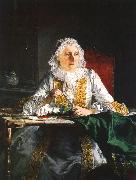 |
Aved, Jacques-Andre-Joseph 
|
|
French Painter, 1702-1766
|
|
 |
AVERCAMP, Hendrick 
|
|
Dutch Baroque Era Painter, 1585-1634
1634). He was the first artist in the northern Netherlands to paint winter landscapes. Before him only a few Flemish artists, among them Pieter Bruegel I and his sons, and Jacob Grimmer, had made winter scenery the main subject of their work. Avercamp created a new genre of Dutch painting by combining the panoramic scope, bright colours and high vantage point of these Flemish models with an emphasis on anecdotal detail.
|
|
 Efimovich Arkhipov-576333.jpg) |
Avram (Abram) Efimovich Arkhipov 
|
|
impression artist
Russian, 1862-1930
|
|
 |
Axel Axelson 
|
|
painted Fiskaregrand, Stockholm in 1854-1892
|
|
 |
Axel Borg 
|
|
Sweden (1847-1916 ) - Painter
|
|
 |
axel gustaf hertzberg 
|
|
1832-1878
Axel Gustaf Hertzberg född 27 augusti 1832 i Jämtland, död 2 september 1878 i Dusseldorf , Tyskland var en svensk bildkonstnär.
Hertzberg ägnade sig först åt porträtteckning och litografi men övergick senare till oljemåleri. Han studerade vid konstakademien i Stockholm 1849-1860. Han gjorde en resa till Finland där han stannade två år. Därefter studerade han konst i Paris, och slutligen Dusseldorf.
Hertzberg blev 1867 agre vid konstakdemien i Stockholm.
|
|
 |
Axel Haig 
|
|
Swedish etcher and architectural draughtsman , 1835-1921
Swedish printmaker, painter and architect. He studied shipbuilding in Karlskrona from 1850 to 1856. The following year he joined the shipbuilders Lawrence Hill & Co. in Glasgow, but soon left to study architecture in London, where he worked with the English architect Ewan Christian (1814-95) and with William Burges. Under the influence of Burges he became especially interested in Gothic architecture. In the late 1870s he began etching, with the intention of illustrating a book on Scotland's medieval architecture. Haig contributed illustrations to numerous English magazines, including The Architect. (For Haig's drawing of William Burges's competition entry for the Law Courts, London) In 1882 he was awarded a medal for his etchings at the Paris Salon and elected an honorary member of the Swedish Royal Academy.
|
|
 |
Axel Johan Fagerplan 
|
|
Born 1788
Died 1865
Country Sweden
|
|
 |
Axel Jungstedt 
|
|
painted Portrait - Lady in Black Dress in 1882
|
|
 |
Axel Kulle 
|
|
painted Den forlorade sonens aterkomst in1882
|
|
 |
Axel Lindman 
|
|
painted Coastal Landscape, Normandie in 1877
|
|
 |
Ayne Bru 
|
|
Ayne (Aine) Bru (probably a Catalanization of Hans Bren) was a 16th century Renaissance painter of German origin who worked in Catalonia. He may have proceeded from Lummen, in the Duchy of Brabant. He is sometimes also called Lucius de Brun. His surname may also suggest provenance from the town of Brenn.
In 1502, he was hired to paint the main altar (retablo) in the church of the monastery of Sant Cugat del Valles, for which he was paid a staggering wage between 1504 and 1507.
On the central panel, Bru depicted the martyrdom of Saint Cucuphas (in Catalan, Sant Cugat) with enormous realism. The executioner cuts the saint's throat while Cucuphas remains tied to a tree trunk. Nearby, there appear another knife (in a basket) and a dog sleeping peacefully. This work is now at the National Art Museum of Catalonia (Museu Nacional d'Art de Catalunya).
The dog from Bru's painting of Cucuphas' martyrdom was later borrowed by Salvador Dale for a painting called "Dale Contemplating Nude" or "Dale Dale Dale".
The vast countryside that serves as a background anachronistically includes the actual monastery of Sant Cugat. Another panel, depicting Saint George (sometimes identified as Saint Candidus or simply as "Warrior Saint"), was attached to this one. It has been rejoined and is visible at the National Art Museum of Catalonia.
Marcel Durliat believes that though the expressionism in this painting is evidence of a Germanic artistic tradition, Bru's Quattrocento depiction of the standing figures in contemporary dress, as well as other details, indicate that the painter may have lived or studied in Northern Italy before moving to Barcelona.
|
|
 |
BACKER, Jacob Adriaensz. 
|
|
Dutch Baroque Era Painter, 1608-1651
Backer was born in Harlingen, but his family moved soon (in 1611) to Amsterdam. Between 1627 and 1633 he and Govert Flinck were pupils of Lambert Jacobsz in Leeuwarden. In 1633 he returned to Amsterdam, where he remained until his death.
His extreme quickness in painting portraits has been particularly noticed, and it is said by his Amsterdam colleague Joachim von Sandrart that he completely finished, in one day, the half length portrait of a lady in full dress, even so early, that she was able to return the same day to Haarlem. Besides being an important portrait painter - some 70 portraits can be attributed to him with certainty, among them the 1642 Company of Cornelis de Graeff voor de Nieuwe Doelen in Amsterdam, on the same wall as Rembrandt's Night Watch - Backer was an excellent painter of religious and mythological paintings. He was especially interested in pastoral subjects, themes from contemporary history, like the huge Crowning of Mirtillo from 1641 in the Brukenthal collection in Sibiu (250 x 250 cm.). In fact, Backer was a leading artist in Amsterdam until his premature death in 1651.
|
|
 |
Bafcop Alexis 
|
|
Flemish ,
1804-1895
|
|
 |
BALDOVINETTI, Alessio 
|
|
Italian Early Renaissance Painter, 1425-1499
|
|
 |
Balthasar Anton Dunker 
|
|
German, 1746-1807
|
|
 |
Balthasar van der Ast 
|
|
(1593/94 - 1657) was a Dutch Golden Age painter who specialized in still lifes of flowers and fruit, as well as painting a number of remarkable shell still lifes; he is considered to be a pioneer in the genre of shell painting. His still lifes often contain insects and lizards. He was born in Middelburg and died at Delft.
|
|
 |
Barend Avercamp 
|
|
(1612-1679) was a Dutch painter.
Avercamp was born in Kampen and was taught by his uncle Hendrick Avercamp, who was also a painter. Barent primarily painted scenes depicting Netherlands in winter. He was a member of the Guild of Saint Luke, and traveled around the Netherlands including Zwolle and Zutphen for his settings and inspiration.
|
|
 |
Baron Antoine-Jean Gros 
|
|
1771-1835
French
Baron Antoine-Jean Gros Galleries
The son of a painter, Antoine Jean Gros was born in Paris on March 16, 1771. At the age of 14 he entered the studio of Jacques Louis David, the acknowledged leader of the classical revival. Although his own work became radically different from David's, he maintained a lifelong respect for his teacher and envisioned himself as the upholder of the Davidian tradition.
In 1787 Gros entered the Acad??mie de Peinture, and when the Acad??mie dissolved in 1793 (a result of the French Revolution) he went to Italy. He met Josephine Bonaparte in Genoa in 1796, and she introduced him to Napoleonic society. Gros entered Napoleon's immediate entourage and accompanied him on several north Italian campaigns. Gros also became involved with Napoleon's program of confiscating Italian art for removal to France.
Gros returned to Paris in 1800 and began to show his Napoleonic paintings in the annual Salons. The most famous of these are the Pesthouse at Jaffa (1804) and Napoleon at Eylau (1808). These works served to deify Napoleon, showing him engaged in acts of heroism and mercy. Stylistically, the paintings were revolutionary:their exotic settings, rich color, agitated space, and general penchant for showing the gruesome specifics of war and suffering differed radically from the cool generalizations of Davidian classicism that Gros had learned as a student. The presentation of contemporary historical events was also new, a harbinger of the realism that developed steadily during the first half of the 19th century in French, American, and English painting. Finally, the emphatic emotionalism of Gros's art established the foundation of romantic painting that Th??odore G??ricault and Eug??ne Delacroix developed after him.
Unlike that of some of his countrymen (David is a case in point), Gros's position did not suffer after the fall of Napoleon. Gros painted for the restored monarchy, for instance, Louis XVIII Leaving the Tuileries (1817), and he decorated the dome of the Panth??on in Paris with scenes of French history (1814-1824). For this Charles X made him a baron in 1824. But these works lack the zest and commitment of Gros's Napoleonic period, perhaps because they were not based on the immediate kinds of historical experiences that had inspired the earlier paintings.
Although marked by considerable public success, Gros's later career was in many ways acutely troubled. Basically, he could not resolve his personal esthetic theories with his own painting or with the work of his younger contemporaries. To the end Gros wished to propagate the classicism of David, and he took over David's studio when the master was exiled in 1816. By the 1820s, however, the revolutionary romanticism of G??ricault and Delacroix, among others, had clearly begun to eclipse classicism, and Gros found himself fighting a lonely and losing battle for conservatism. Ironically, he was fighting a trend that his own best work had helped to originate. As he persisted, moreover, his own painting began to show a diffident mixture of classic and romantic attitudes. Thus, while he was inherently a romantic, he tragically came to doubt himself. Gros died on June 26, 1835, apparently a suicide.
|
|
 |
Bartolomeo Altomonte 
|
|
Bartolomeo Altomonte, also known as Bartholomäus Hohenberg (24 February 1694 - 11 November 1783), was an Austrian baroque painter who specialized in large scale frescoes. He was the son of Martino Altomonte, also a painter.
|
|
 |
BASSA, Arnaldo 
|
|
(c. 1350-1400)
|
|
 |
Benno Adam 
|
|
(July 15, 1812, Munich - March 9, 1892, Kehlheim) was a German painter.
He specialised in animal portraits and market and hunting scenes.
He was the son of painter Albrecht Adam.
|
|
 |
BENSON, Ambrosius 
|
|
Flemish Northern Renaissance Painter, ca.1495-1550
South Netherlandish painter of Italian birth. In 1518 he acquired Bruges citizenship, and in 1519 he was admitted to the guild of painters and saddlemakers there as an independent master, with the comment that he was 'from Lombardy'. He may have been from Ferrara, although he was originally called Ambrogio Benzone, taking his first name from the patron saint of Milan, the capital of Lombardy. He was probably attracted to Bruges by its commercial and artistic reputation. Initially he worked in the studio of Gerard David, by whom he was profoundly influenced, but after a few months the relationship went wrong and the younger painter brought a case against David. Benson's first marriage was to Anna Ghyselin, who bore him two sons, Willem Benson (1521/2-1574) and Jan Benson (before 1530-before 1581), both of whom became artists. From his second marriage, to Josyne Michiels, a daughter Anna was born, and he had two other daughters from various extra-marital relationships. Benson was an affluent and successful man: he owned several houses, for one of which he gave eight paintings in half payment (which gives some idea of the value of his works at the time). Benson twice received commissions from city magistrates to decorate their new county hall and was a member of the city council on three occasions; he also held important offices within the painters' guild, including dean (1537-8 and 1543-4) and governor (1540-41). His pupils included his two sons, and Joachim Spaers (1541) and Jacob Vinson (Fynson; 1549).
|
|
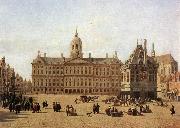 |
BERCKHEYDE, Gerrit Adriaensz. 
|
|
Dutch Baroque Era Painter, 1638-1698
Brother of Job Berckheyde. Gerrit specialized in a particular type of architectural subject, the TOWNSCAPE. His painted work shows a debt not only to Pieter Saenredam's conception of the building portrait but also to Saenredam's refined draughtsmanship and dispassionate attitude; these qualities mark Berckheyde as a classicist and akin to Vermeer. Berckheyde favoured views of monuments on large open squares, a choice that distinguishes him from the other great Dutch townscape painter, Jan van der Heyden, who preferred views along canals in which clarity was sacrificed for pictorial effect.
|
|
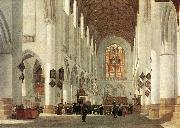 |
BERCKHEYDE, Job Adriaensz 
|
|
Dutch painter (b. 1630, Haarlem, d. 1693, Haarlem).
He was apprenticed on 2 November 1644 to Jacob Willemsz. de Wet, whose influence is apparent in his first dated canvas, Christ Preaching to the Children (1661; Schwerin, Staatl. Mus.), one of the few biblical scenes in his oeuvre. On 10 June 1653 he repaid a loan from the Haarlem Guild of St Luke, which he subsequently joined on 10 March 1654. During his stay in Heidelberg, Job painted portraits and hunting scenes at the court of the Elector Palatine, who rewarded him with a gold chain, perhaps the one he wears in his early Self-portrait (c. 1655; Haarlem, Frans Halsmus.), his only documented work from the 1650s. Job is better known for his later work, which consists mainly of interior views of St Bavo's church in Haarlem and simple genre scenes recalling those of his Haarlem contemporaries Adriaen van Ostade and Jan Steen.
|
|
|
|
|
|
|
|
|
| Wholesale China Oil Painting Wholesale Oil Painting China Xiamen Portrait Reproduction on canvas Chinese Oil Painting Wholesale USA Oil Painting |
|
|
|
|